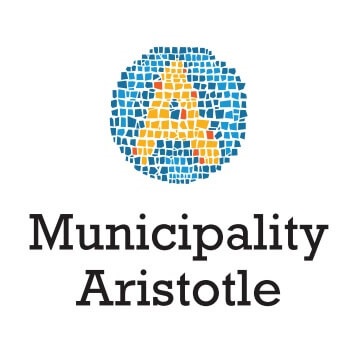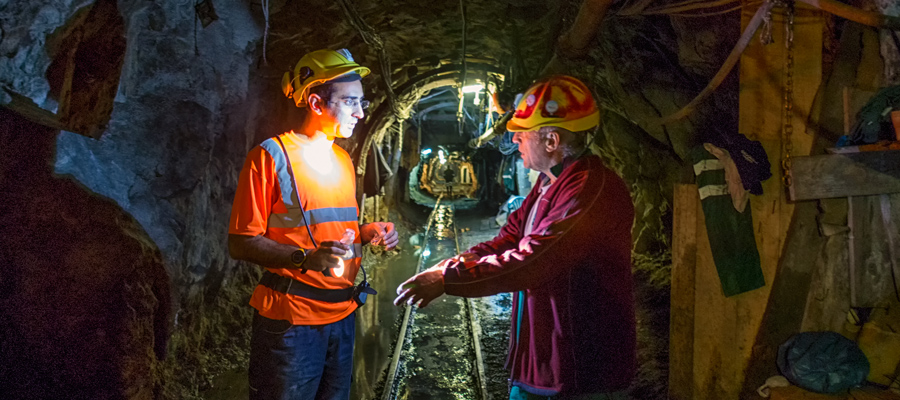The first attempt to exploit the Cassandria iron pyrites through beneficiation dates back to 1907. That year, the first hydro-mechanical washing plant was put into operation near the bay of Stratoni by the French company Societe Ottomane des Mines de Cassandra. With the operation of the beneficiation plant in Stratoni, new prospects were created for the village.
“Our village was shining! It was the only one with electricity, thanks to the diesel engines of the company, where my father worked. The other villages envied us, and we called our village ‘Little Paris.’ You see, the company was originally French, and that’s probably where the name came from,” says Despoina Stilianidou in her book “The Despoina of Stratoni.”
From the same book, we learn more about the conditions and life of the miners: “Most of the residents of the area worked in the terrible Madem Lakko, with its deep underground galleries hundreds of meters below the ground. It was a truly wretched place, with no natural beauty, buried between the mountains. It was not a place of work, but a place of martyrdom for hundreds of workers who entered the galleries at dawn and emerged ‘living dead’ at sunset. No working hours, no healthcare, no holidays, just one Sunday […].”
Mining ore from the depths of the earth is inherently a challenging task. As with most labor-intensive work, conditions and technology improved over time, through fire and steel. If we refer to ancient times, miners were slaves and were referred to as “bag-carrying slaves,” with mining taking place under the light of clay oil lamps, working in the tunnels for ten hours, lying sideways or on their backs.
In the modern era, initially, large manual drills (air hammers) were used for both tunneling and ore extraction. The dust created from their use was no ordinary dust; part of it consisted of silicon dioxide (quartz). Simply put, glass.
The human body, with its functions, can expel and filter many kinds of particles. However, if the glass particle was of a specific size that perfectly matched the alveoli of the lungs, it would wedge there. Over time, many such particles would accumulate, reducing the person’s respiratory capacity. Moreover, the part of the lung that got clogged would necrotize, ultimately destroying the organ.
In those times, a miner would not be able to work after a year and a half of work, as he would be gasping for breath. He would then retire due to an occupational disease, the so-called miner’s disease, pneumoconiosis. Some of them lived three to five years, at most ten—no more. This was between the 1950s and 1960s. Until then, they did not know why this was happening. Once they figured it out, they immediately started the method of drilling with water. Today, in all drillings, plenty of water runs through, carrying away the glass particles so that they are not inhaled.
The Explosives
Later, the holes would be filled with explosives. About 18 to 20 holes on a face, as there was no electric ignition at the time, they would ignite with a fuse, using a cigarette to detonate them. The blaster had to smoke! The lit cigarette was the most reliable ignition method! There were always two of them. They would light their cigarette—usually hand-rolled—and simultaneously ignite all the fuses.
The explosions would always take place twice a day, at specific times. This was for safety reasons so that everyone would know they should have evacuated, and to allow proper ventilation of the tunnels before the next shift began. The first one was between 1:00 and 1:15 PM, and the second between 9:00 and 9:15 PM. In the past, there were three explosions, including one in the morning. Since the Greek Gold company took over, for reasons related to not disturbing the residents of Stratoni with the sound of the explosions, the third shift explosions were abolished. After the explosion, the miners would go with a pick and basket and load the ore onto wagons. Considering that the basket could hold 10 to 12 liters of water and the specific gravity of the ore was nearly seven times that of water, a half-filled basket weighed 35 to 40 kg. These conditions were made even harder by the heat and unbearable humidity…
A Testimony
“Consider how tough this work was when it happened all day long. Their work was very exhausting. When they came out, you couldn’t see their faces. Only their eyes would shine. The conditions were extremely difficult,” recounts Ioannis Drapaniotis, a third-generation miner, raised literally inside the mines and trained as a mining engineer.
“I remember when the mine still extracted iron pyrite. In some faces where the deposit was quite rich, a strange phenomenon would occur. The air that was pumped into the tunnel would quickly oxidize the pyrite. The oxidation of pyrite could happen very quickly, almost resembling burning. The chemical reaction with the air would raise the temperature of the ore so much that you couldn’t touch it with your hand. After the sulfur burned, in addition to the rise in temperature, the gases created were suffocating. They would burn your lungs, and you would start coughing. You could manage to fill only one wagon, then you’d have to go out and drink some water to recover.”
Ventilation was the next major problem. In blind tunnels, the oxygen content sometimes fell below the life-sustaining threshold, and there were instances of people dying from asphyxiation. In 1990, someone died due to this reason. In the mine, there is a rule that everyone must circulate in pairs. Fainting was frequent, but it was prevented. The person who died was alone, and by the time they found him, it was too late.
Modern Methods
Another danger was the risks stemming from the method of ceiling collapse, which led to the creation of voids after the ore was extracted. As extraction continued, more holes appeared in the ground, resulting in cracks and subsidence on the surface over time. In fact, some houses in Stratoniki suffered significant damage. This, along with environmental degradation, led to division within the local community about the mine’s operations in the past.
However, today, the alternating cuts and stowing method is applied, where, once the ore is exhausted in a tunnel, it is refilled. The material used for filling is a mixture of waste material from the beneficiation process (tailings) and cement. This way, the soil integrity is maintained, as much of the barren material from the mine is returned to the old tunnels without altering the external environment. The beneficiation plant, or “washer,” as it is called, is the process by which useful materials are separated from waste. The ore, as it comes out of the earth, has a small content, which is not commercially viable (5% to 9% lead and 7% to 10% zinc). After crushing, grinding, and adding reagents (strong chemicals), differential flotation occurs, separating the useful minerals, galena (lead sulfide), and sphalerite (zinc sulfide), as concentrates.
The produced concentrates are then thickened and filtered and placed in a specially designed, roofed area in the loading facilities. From there, they are loaded onto ships and exported to smelters abroad, as Greece does not have any smelting plants. As for the waste materials (tailings), the management system includes the initial separation of the coarse fraction, which is used in the mine as stowing material, after mixing with cement and water.
For the remaining fine tailings, after processing in the filter press and in the form of dewatered solids, they are transferred to the solid waste disposal site. Until 1978, the waste material was dumped into the sea. The thousands of tons of material that ended up in the sea created the huge beach in front of Stratoni, extending the coastline by nearly 10 to 20 meters. It caused significant pollution back then, but today it remains only a large beach.
The work of the miner has greatly improved today. In the new tunnels, you can even move around with your car! Specialized vehicles are now responsible for loading the ore and drilling holes for explosives. Powerful fans fill the interior of the tunnels with air. Explosives are now detonated electronically, so there’s no need for blasters to smoke! Still, the work of miners remains quite tough. No matter how advanced technology becomes, the smell of the air, the absolute darkness, the unsettling silence, the warmth, the humidity, and, finally, the skill and perception needed to ensure everything is going well, will never change.
In ancient Greece, they believed that “strength and prosperity are hidden within the earth’s nature.” From the mines of Cassandra, Alexander the Great obtained gold to fund his campaigns. Here worked the legendary Alexis Zorbas from Nikos Kazantzakis’ story. Here the beloved poet of sailors, Nikos Kavvadias, fell in love. And here, even today, there exists a nearly romantic connection between people and the land—often self-destructive.



